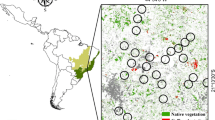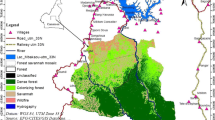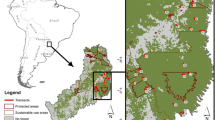Abstract
Primates are among the globally imperiled fauna requiring urgent conservation interventions to protect their habitat. Information on species distribution and factors influencing it are vital to species management and habitat protection. In this study, we assessed habitat occupancy of the lion-tailed macaque (Macaca silenus), bonnet macaque (M. radiata), and black-footed gray langur (Semnopithecus hypoleucos) that occur in the Kudremukh Wildlife Division, a large protected area network in the central Western Ghats. We examined the influence of habitat variables on the occupancy probability of these primates. We carried out four temporally replicated detection/non-detection surveys to assess detection probability and site occupancy of the primate species. We surveyed 244 sites of 5 Km2, with each site surveyed for 4 days, to assess detection probability and site occupancy. Among the three species, the langur had the highest habitat occupancy estimate (0.66 ± 0.05SE) and the lion-tailed macaque had the lowest estimate (0.28 ± 0.08SE). The habitat occupancy estimate for the bonnet macaque was (0.56 ± 0.05SE). Wet and semi-evergreen forest cover and mean elevation positively influenced the lion-tailed macaque’s occurrence. Covariates influencing bonnet macaque’s occurrence were plantations, semi-evergreen and moist deciduous forests, and non-forest areas. Mean elevation negatively affected its occurrence. Wet evergreen forests and plantations positively influenced the occurrence of the langur. We examined spatial segregation between the species based on their site occupancy. Pairwise comparisons revealed a significant negative association between the bonnet macaque and the other two primates. However, we found a significant positive association between the lion-tailed macaque and the langur. We discuss these results and their implications for conservation of primates in the region. Given the cost-effectiveness of carrying out surveys at large spatial scales, we recommend occupancy surveys for future surveys of forest primates.



Similar content being viewed by others
Change history
11 February 2022
A Correction to this paper has been published: https://doi.org/10.1007/s10329-022-00977-3
References
Arroyo-Rodríguez V, González-Perez IM, Garmendia A, Solà M, Estrada A (2013) The relative impact of forest patch and landscape attributes on black howler monkey populations in the fragmented Lacandona rainforest, Mexico. Landsc Ecol 28(9):1717–1727
Bapureddy G, Santhosh K, Jayakumar S, Kumara HN (2015) Estimate of primate density using distance sampling in the evergreen forests of the central Western Ghats, India. Current Sci 108(1):118–123
Burnham K, Anderson D (2002) Model selection and multi-model inference, 2nd edn. Springer, New York
Carretero-Pinzón X, Defler TR, McAlpine CA, Rhodes JR (2017) The influence of landscape relative to site and patch variables on primate distributions in the Colombian Llanos. Land Ecol 32(4):883–896
Almeida-Rocha JMD, Peres CA, Oliveira LC (2017) Primate responses to anthropogenic habitat disturbance: a pantropical meta-analysis. Biol Conserv 215:30–38
Erinjery JJ, Kavana TS, Singh M (2017a) Behavioural variability in Macaques and Langurs of the Western Ghats, India. Folia Primatol 88(3):293–306
Erinjery JJ, Kumar S, Kumara HN et al (2017b) Losing its ground: a case study of fast declining populations of a ‘least-concern’ species, the bonnet macaque (Macaca radiata). PLoS One 12(8):e0182140
Estrada A, Garber PA, Rylands AB et al (2017) Impending extinction crisis of the world’s primates: why primates matter. Sci Adv 3(1):e1600946
Estrada A, Garber PA, Mittermeier RA, Wich S, Gouveia S, Dobrovolski R, Setiawan A et al (2018) Primates in peril: the significance of Brazil, Madagascar, Indonesia and the Democratic Republic of the Congo for global primate conservation. PeerJ 6:e4869. https://doi.org/10.7717/peerj.4869
Gadelha JR, de Andrade Melo ÉR, da Silva MND, da Silva Júnior AP, Filgueiras BKC, Pontes ARM (2017) Habitat heterogeneity as a local and regional-scale driver of primate assemblage structure in northernmost Brazilian Amazonia. Ani Biol 67(3–4):263–286
Ghosh-Harihar M, An R, Athreya R et al (2019) Protected areas and biodiversity conservation in India. Biol Conserv 237:114–124
Green S, Minkowski K (1977) The lion-tailed monkey and its South Indian rain forest habitat. Primate Conserv 289–337
Gubbi S, Mukherjee K, Swaminath MH, Poornesha HC (2016) Providing more protected space for tigers Panthera tigris: a landscape conservation approach in the Western Ghats, southern India. Oryx 50(2):336–343
Guillera-Arroita G, Lahoz-Monfort JJ, Milner-Gulland EJ, Young RP, Nicholson E (2010) Using occupancy as a state variable for monitoring the Critically Endangered Alaotran gentle lemur Hapalemur alaotrensis. Endangered Species Res 11(2):157–166
Hines JE (2006) PRESENCE – Software to estimate patch occupancy and related parameters. Version 12.4. USGS-PWRC. http://www.mbr-pwrc.usgs.gov/software⁄presence.html
Johnson CL, Hilser H, Linkie M, Rahasia R, Rovero F, Pusparini W, Bowkett AE et al (2020) Using occupancy-based camera-trap surveys to assess the Critically Endangered primate Macaca nigra across its range in North Sulawesi, Indonesia. Oryx 54(6):784–793
Jones KR, Venter O, Fuller RA, Allan JR, Maxwell SL, Negret PJ, Watson JE (2018) One-third of global protected land is under intense human pressure. Science 360(6390):788–791
Joppa LN, Loarie SR, Pimm SL (2008) On the protection of “protected areas”. Proc Natl Acad Sci 105(18):6673–6678
Karanth KK, Nichols JD, Karanth KU, Hines JE, Christensen NL Jr (2010) The shrinking ark: patterns of large mammal extinctions in India. Proc R Soc B 277(1690):1971–1979
Kavana TS, Erinjery JJ, Singh M (2015) Folivory as a constraint on social behaviour of langurs in south India. Folia Primatol 86(4):420–431
Krishnadas M, Agarwala M, Sridhara S, Eastwood E (2018) Parks protect forest cover in a tropical biodiversity hotspot, but high human population densities can limit success. Biol Conserv 223:147–155
Kumar A (1987) The ecology and population dynamics of the lion-tailed macaque (Macaca silenus) in South India (Doctoral dissertation, University of Cambridge)
Kumara HN, Kumar S, Singh M (2010) Of how much concern are the ‘least concern’ species? Distribution and conservation status of bonnet macaques, rhesus macaques and Hanuman langurs in Karnataka, India. Primates 51(1):37–42
Kumar S, Sundararaj P, Kumara HN, Pal A, Santhosh K, Vinoth S (2018) Prevalence of gastrointestinal parasites in bonnet macaque and possible consequences of their unmanaged relocations. PLoS One 13(11):e0207495
Kumara HN, Singh M (2004a) The influence of differing hunting practices on the relative abundance of mammals in two rainforest areas of the Western Ghats, India. Oryx 38:320–327
Kumara HN, Singh M (2004b) Distribution and abundance of primates in rain forests of the Western Ghats, Karnataka, India and the conservation of Macaca silenus. Int J Primatol 25(5):1001–1018
Kumara HN, Singh VR (2008) Status of Macaca silenus in the Kudremukh forest complex, Karnataka, India. Int J Primatol 29(3):773–781
Kumara HN, Sinha A (2009) Decline of lion-tailed macaque populations in the Western Ghats, India: identification of a viable population and its conservation in Karnataka state. Oryx 43:292–298
Kumara HN, Singh M, Kumar S (2006) Distribution, habitat correlates, and conservation of Loris lydekkerianus in Karnataka, India. Int J Primatol 27(4):941–969
Kumara HN, Sasi R, Suganthasakthivel R, Singh M, Sushma HS, Ramachandran KK, Kaumanns W (2014) Distribution, demography, and conservation of lion-tailed macaques (Macaca silenus) in the Anamalai Hills Landscape, Western Ghats, India. Int J Primatol 35(5):976–989
Levin SA (1992) The problem of pattern and scale in ecology: the Robert H. MacArthur award lecture. Ecology 73(6):1943–1967
MacKenzie DI, Bailey LL (2004) Assessing the fit of site-occupancy models. J Agric Biol Environ Stat 9(3):300–318
MacKenzie DI, Nichols JD, Royle JA, Pollock KH, Bailey L, Hines JE (2017) Occupancy estimation and modeling: inferring patterns and dynamics of species occurrence, 2nd edn. Elsevier, USA
Madhusudan MD, Karanth KU (2002) Local hunting and the conservation of large mammals in India. Ambio 31:49–54
Maxwell SL, Fuller RA, Brooks TM, Watson JE (2016) Biodiversity: the ravages of guns, nets and bulldozers. Nature 536(7615):143
Myers N, Mittermeier RA, Mittermeier CG, Da Fonseca GA, Kent J (2000) Biodiversity hotspots for conservation priorities. Nature 403(6772):853–858
Nag C, Karanth KP, Gururaja KV (2014) Delineating ecological boundaries of hanuman Langur species complex in peninsular India using MaxEnt modeling approach. PLoS One 9(2):e87804. https://doi.org/10.1371/journal.pone.0087804
Neilson E, Nijman V, Nekaris KAI (2013) Conservation assessments of arboreal mammals in difficult terrain: occupancy modeling of pileated gibbons (Hylobates pileatus). Int J Primatol 34(4):823–835
Nichols JD, Williams BK (2006) Monitoring for conservation. Trends Ecol Evol 21(12):668–673
Ram MS, Marne M, Gaur A, Kumara HN, Singh M, Kumar A et al (2015) Pre-historic and recent vicariance events shape genetic structure and diversity in endangered Lion-Tailed Macaque in the Western Ghats: implications for conservation. PLoS One 10(11):e0142597. https://doi.org/10.1371/journal.pone.0142597
Ramachandra TV, Setturu B, Chandran S (2016) Geospatial analysis of forest fragmentation in Uttara Kannada District, India. For Ecosyst 3(1):10
Ramachandra TV, Bharath S, Gupta N (2018) Modelling landscape dynamics with LST in protected areas of Western Ghats, Karnataka. J Environ Manage 206:1253–1262
Ramesh KP, Kumara HN, Priya MM, Sushma HS, Meharabi KM, Udayraj S (2018) Conservation status of primates in the central Western Ghats, Karnataka, India. Primate Conserv 32:1–9
Ramesh KP (2014) Management plan of Kudremukh National Park for the Period 2013–14 to 2022–23. Principal Chief Conservator of Forests (Wildlife) OM No: D1/WL/CR.03/2010–11 dated 28.02.2014, Karnataka Forest Department, Bangalore
Ramesh KP (2016a) Management plan of Mookambika Wildlife Sanctuary for the Period 2015–16 to 2024–25. Principal Chief Conservator of Forests (Wildlife) OM No: D1/WL/CR.03/2010–11 dated 23.04.2016, Karnataka Forest Department, Bangalore
Ramesh KP (2016b) Management plan of Someshwara Wildlife Sanctuary for the Period 2015–16 to 2024–25. Principal Chief Conservator of Forests (Wildlife) OM No: D1/WL/CR.03/2010–11 dated 14.06.2016, Karnataka Forest Department, Bangalore
Ripple WJ, Abernethy K, Betts MG et al (2016) Bushmeat hunting and extinction risk to the world’s mammals. R Soc Open Sci 3(10):160498
Santhosh K, Kumara HN, Velankar AD, Sinha A (2015) Ranging behavior and resource use by lion-tailed macaques (Macaca silenus) in selectively logged forests. Int J Primatol 36(2):288–310
Schäffler L, Saborowski J, Kappeler PM (2015) Agent-mediated spatial storage effect in heterogeneous habitat stabilizes competitive mouse lemur coexistence in Menabe Central Western Madagascar. BMC Ecol 15(1):1–15
Schäffler L, Kappeler PM, Halley JM (2021) Mouse lemurs in an assemblage of cheirogaleid primates in Menabe Central, Western Madagascar-three reasons to coexist. Front Ecol Evol 9:149
Sharma N, Madhusudan MD, Sinha A (2014) Local and landscape correlates of primate distribution and persistence in the remnant lowland rainforests of the upper Brahmaputra Valley, Northeastern India. Conserv Biol 28(1):95–106
Simard M, Pinto N, Fisher JB, Baccini A (2011) Mapping forest canopy height globally with spaceborne lidar. J Geophys Res. https://doi.org/10.1029/2011JG001708
Singh M, Roy K, Singh M (2011) Resource partitioning in sympatric langurs and macaques in tropical rainforests of the central Western Ghats, South India. Am J Primatol 73(4):335–346
Singh M, Singh M, Kumara HN, Kumar MA, d’Souza L (1997) Inter-and intra-specific associations of non-human primates in Anaimalai Hills, South India. Mammalia 61(1):17–28
Singh M, Singh M, Kumar MA, Kumara HN, Sharma AK, Kaumanns W (2002) Distribution, population structure, and conservation of lion-tailed macaques (Macaca silenus) in the Anaimalai Hills, Western Ghats, India. Am J Primatol 57(2):91–102
Singh M, Kumar A, Kumara HN (2020a) Macaca silenus. The IUCN Red List of Threatened Species 2020:e.T12559A17951402. https://doi.org/10.2305/IUCN.UK.2020-2.RLTS.T12559A17951402.en. Accessed 01 Dec 2020
Singh M, Kumara HN, Kumar A, Nag C (2020b) Semnopithecus hypoleucos ssp. hypoleucos. The IUCN Red List of Threatened Species 2020:e.T167541339A167541549. https://doi.org/10.2305/IUCN.UK.2020-2.RLTS.T167541339A167541549.en. Accessed 01 Dec 2020
Singh M, Kumara HN, Kumar A (2020c) Macaca radiata. The IUCN Red List of Threatened Species 2020:e.T12558A17951596. https://doi.org/10.2305/IUCN.UK.2020-2.RLTS.T12558A17951596.en. Accessed 01 Dec 2020
Sushma HS, Singh M (2006) Resource partitioning and interspecific interactions among sympatric rain forest arboreal mammals of the Western Ghats, India. Behav Ecol 17(3):479–490
Sushma HS, Mann R, Kumara HN, Udhayan A (2014) Population status of the endangered Lion-Tailed Macaque Macaca silenus in Kalakad-Mundanthurai Tiger Reserve, Western Ghats, India. Primate Conserv 28:171–178
Tregidgo DJ, Barlow J, Pompeu PS, de Almeida RM, Parry L (2017) Rainforest metropolis casts 1,000-km defaunation shadow. Proc Nat Acad Sci 114(32):8655–8659
Umapathy G, Kumar A (2000) The occurrence of arboreal mammals in the rain forest fragments in the Anamalai Hills, south India. Biol Conserv 92(3):311–319
Umapathy G, Hussain S, Shivaji S (2011) Impact of habitat fragmentation on the demography of lion-tailed macaque (Macaca silenus) populations in the rainforests of Anamalai Hills, Western Ghats, India. Int J Primatol 32(4):889–900
Williams BK, Nichols JD, Conroy MJ (2002) Analysis and management of animal populations. Academic Press
Acknowledgements
We thank Sri Ajai Misra IFS (Retired) for his support and encouragement for the successful completion of this survey. We also thank Dr. Malathi Priya M, IFS, for her suggestions, support, and cooperation throughout the survey. We thank Sri B. Bhaskar, Sri Sadanand, and Smt. N.K. Nirmala. We also thank the following Range Forest Officers: Sri Shivaram Achar, Sri Sharath Shetty, Sri A.A. Gopal, Sri S.M. Kadolkar, Sri Tanuj Kumar, Sri I.R. Dafedar, and Sri Dhavale. We thank Sri H. Shreedhar, Sri S. Hariprasad, and Sri Vincent for their support during the survey. We thank the Information Communication Technology (ICT) cell of the Karnataka Forest Department providing requisite files and maps needed for the survey. We thank the Kudremukh Wildlife Division, Karkala, Karnataka State Forest Department for logistics and other support towards successful completion of this work. We are thankful to the two anonymous reviewers whose insightful comments substantially improved the manuscript.
Author information
Authors and Affiliations
Corresponding author
Additional information
Publisher's Note
Springer Nature remains neutral with regard to jurisdictional claims in published maps and institutional affiliations.
The original online version of this article was revised to correct the second author name.
About this article
Cite this article
Sushma, H.S., Ramesh, K.P. & Kumara, H.N. Determinants of habitat occupancy and spatial segregation of primates in the central Western Ghats, India. Primates 63, 137–147 (2022). https://doi.org/10.1007/s10329-021-00966-y
Received:
Accepted:
Published:
Issue Date:
DOI: https://doi.org/10.1007/s10329-021-00966-y




